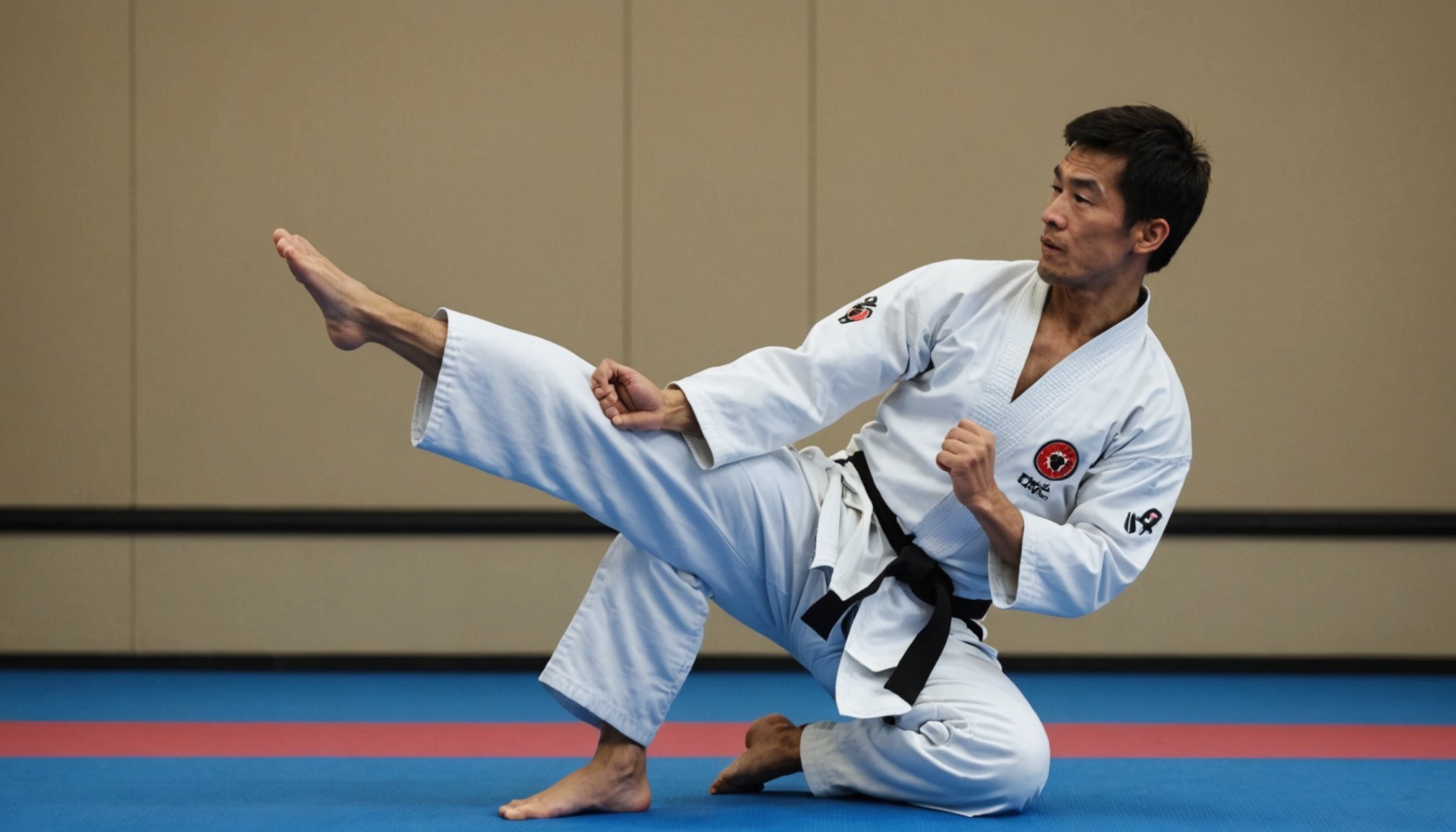Importance of Dynamic Stretching in Karate
Dynamic stretching is a crucial component of training for martial artists, particularly in karate. Unlike static stretching, dynamic stretching involves active movements that mimic the activities of karate, preparing the body for enhanced performance. These stretching exercises are critical in raising core body temperature, increasing heart rate, and improving muscular function, all essential for optimal karate performance.
Flexibility is vital in karate as it enhances both offensive and defensive techniques. Improved flexibility benefits practitioners by increasing their range of motion, which is essential for executing high kicks and swift blocks more effectively. As a result, karatekas are able to perform with greater power and accuracy, decreasing the likelihood of injury.
Also to discover : Mastering defense: how biomechanics transforms training for uk fighters
Scientific research has demonstrated that incorporating dynamic stretching into training routines boosts athletic performance. For example, studies indicate that athletes engaged in regular dynamic stretching routines exhibit superior agility, speed, and reaction times. This evidence underscores the importance of embracing dynamic stretching for any athlete aiming to elevate their karate performance.
Integrating dynamic stretching into daily training regimes not only augments technical skill but also contributes to overall fitness and well-being. Ensuring that muscles are adequately conditioned through these purposeful movements maximises effectiveness and ensures flexibility benefits are realised.
This might interest you : Boost your fencing lunge: transform uk athletes” performance with dynamic plyometric training techniques
Essential Dynamic Stretching Techniques for UK Practitioners
Dynamic stretching techniques are vital for UK practitioners aiming to improve flexibility and movement efficiency in karate exercises. Among these techniques, leg swings are particularly effective.
Leg Swings
Leg swings involve swinging the leg forward and backward in a controlled manner. They are beneficial for loosening the hips and hamstrings, which are crucial in karate for fluid, dynamic movements. To perform this exercise correctly, stand next to a wall or hold onto a support for balance. Begin by swinging one leg forward and backward, ensuring the movement is smooth and controlled. Common mistakes include swinging too aggressively or with improper form, which can lead to strain rather than flexibility gains. For optimal performance, incorporate leg swings into your warm-up routine, starting with 10-15 repetitions per leg. This not only prepares the muscles for vigorous activity but also enhances their elasticity, reducing injury risk. Remember, consistency and correct technique are key to reaping the full benefits of this dynamic stretching technique. For UK practitioners focusing on karate, leg swings offer a substantial improvement in performing kicks and stances, ultimately enhancing overall performance.
Tailored Stretching Routines for Karate Training
As karate practitioners, engaging in appropriate karate stretching routines is pivotal to preventing injury and promoting flexibility. Implementing dynamic warm-ups as part of these routines primes the body for training integration. Here’s an insight into how you can tailor your stretching regimen.
Firstly, dynamic stretching should adjust according to skill levels. Beginners might start with simple leg swings, torso twists, and arm circles. As practitioners progress, incorporating more complex movements like high kicks or deep lunges can enhance flexibility and strength. These help prepare the body dynamically, mirroring the intensity of karate movements.
Customizing routines is equally important. An effective method is assessing individual strengths and weaknesses. For instance, a practitioner with tight hamstrings should focus more on leg stretches. This customization aids in targeting specific areas that require improvement.
Consistency is the cornerstone for progress. Establishing a regular routine, such as stretching before every session, aids in gradually increasing flexibility and building muscle memory. Missing stretches or performing them sporadically hinders progress and might increase injury risk. Remember, consistency pays off, so be diligent in your practice.
Incorporating these practices ensures an effective and enjoyable karate training experience, fostering both physical and skill enhancement.
Integrating Dynamic Stretching into Your Karate Practice
To integrate stretching into your karate routine effectively, start with specific karate training tips focused on dynamic stretching. Dynamic stretching enhances mobility and flexibility, crucial for martial arts. Begin by incorporating it into your warm-up phase. This prepares your muscles and reduces injury risk, allowing for a more productive training session.
Adopt strategies to make stretching a habitual part of karate practice. One method is to set a consistent schedule. For instance, dedicate 10-15 minutes at the beginning and end of your sessions specifically for dynamic stretches. Gradually increase the complexity and intensity as your flexibility and confidence grow.
Promote mindfulness and body awareness during stretching. Actively focus on your breathing and the sensations within your body. This enhances the mind-body connection, allowing you to notice imbalances or tension areas needing attention. Being attentive during stretches not only reduces injury risk but also boosts performance.
In summary, integrating dynamic stretching into your routine doesn’t just prepare your body physically but enriches your entire practice enhancement approach. Listen to your body and adjust your techniques accordingly; you’ll find yourself not only improving in karate but enjoying the process more thoroughly.
Benefits of Flexibility in Martial Arts
Flexibility plays a crucial role in enhancing martial arts performance. A flexible body allows for a greater range of motion, enabling practitioners to execute kicks, punches, and defensive manoeuvres with improved efficiency. This increased mobility can lead to more effective and powerful techniques, offering a competitive edge in both training and real-world self-defense situations.
Another significant advantage of improved flexibility is its contribution to injury prevention. When the body’s muscles and joints are more pliable, they are less prone to strains, tears, or other injuries often associated with the rigorous demands of martial arts. Enhanced flexibility enables the body to better withstand sudden movements and impacts, therefore reducing the risk of injury.
Furthermore, the long-term benefits of maintaining flexibility are clear in competition scenarios. Over time, a practitioner with superior flexibility can achieve sustained performance levels, as their body remains agile and less susceptible to fatigue and wear. The ability to execute movements freely and without restriction is advantageous not only in a competitive setting but also in everyday self-defense encounters. As a result, flexibility should not be overlooked in any martial artist’s training regimen, given its multifaceted benefits for both performance and health.
Differences in Stretching Practices Among UK Karate Schools
In the kaleidoscope of UK karate practices, diverse dynamic stretching methods reflect the richness of the country’s martial arts culture. Each dojo may adopt unique techniques, influenced by a variety of factors including tradition and instructor preferences. Notably, dynamic stretching—often involving controlled leg swings and torso twists—stands as a foundational element in many UK karate schools.
Cultural influences play a significant role in how stretching variations manifest across different schools. Traditional Japanese practices may blend with local customs, leading to innovative approaches to flexibility and warm-up routines. This fusion ensures each dojo has its own distinctive flavour, adding to the rich tapestry of martial arts culture in the UK.
For practitioners exploring UK karate practices, it’s beneficial to experiment with these stretching variations. This exploration can enhance flexibility, prevent injury, and increase overall performance in martial arts training. Karate schools often encourage students to embrace diverse stretching approaches, tailoring them to personal needs and goals. By understanding and adopting a variety of stretching techniques, students can enrich their martial arts journey and develop a more holistic understanding of their practice.











